

|
Home Updates Hydros Cars Engines Contacts Links Contact On The Wire |
Ron Thrower, his cars, and a remarkable discovery.
|
|
Ron Thrower was a high profile British tethered car racer during the mid 1950s, but only had a short lived career before racing in the UK faded away. Apart from mentions in the specialist magazines and a number of articles that he published in Model Maker, that was as far as our knowledge extended, until a visit to an enthusiast on the South Coast in 2016. That set in motion a series of events, which has resulted in this article. Amongst the items we were shown was a large cardboard box that had been bought from a model shop in Oxford, some sixty or so years previously. In the box were Ron Thrower's 2.5cc Oliver 'Bottom's Up', which we discovered he had used to finish second in the 1954 European Championships, and his 1.5cc prototype GRP car that was described in Model Maker in 1957. |
Apart from being allowed to take the photos that we published in Pitbox in 2017 we could do no more, until 2023 that is. Having been told previously that the owner was hanging on to his tethered cars we were contacted to say that he had now decided to sell all his cars, which included the entire box and all it contained, allowing us a closer look at the contents.
|
This has enabled us to explore the career of Ron Thrower further, along with the cars that he raced and built. It has also enabled us to add an entire postscript that ties in with another article published in Model Maker, but with nothing tangible to back it up until now. Ron Thrower was one of the new breed of tethered car racers in the UK in the 1950s, just sixteen years old when he started with the Edmonton Club in 1952, by his own admission not an apprenticed engineer and neither did he have any sort of workshop other than the kitchen table. His first car was built with a bent up sheet chassis and a second-hand 2cc ED Comp Special running through brass bevel gears. These lasted all of four laps, requiring an entirely new car with a clutch and steel gears. His first official event after joining the Edmonton Club was a Pioneer Club meeting at the Horticultural Halls. After four meetings he had managed to get the car up to 35mph, but he had been truly 'bitten by the bug' and so began the pursuit of speed, which required more serious hardware, which he could not afford. |
|
Edmonton members were very much at the forefront of tethered car racing by then with double European Champions Jim Dean and Stan Drayson, the Snelling Brothers, who were British record holders, and also very closely involved with the development of the Oliver twinshaft engine from its inception. They were also responsible for persuading the Olivers to develop the ball bearing Tiger MkI. Another prominent member was Paul Zere of ZN Motors who was to become another integral part of Ron Thrower's future career. It is obvious from contemporary reports that the Snelling brothers were also instrumental in encouraging and helping him.
|
Ron started racing seriously in 1953, his first reported meeting being the Meteor Club 'Coronation' event late in 1953, travelling up to Staffordshire with a contingent from London. He was running a 1.5cc Oliver 'Bottom's Up' fitted with an ex Snelling MkII Tiger motor, the car being prepared by Paul Zere. Right: Ron at Meteor with 1.5cc 'Bottom's Up' prepared here by Zere |
|
|
Just a few months later, Ron was lining up with Europe's very best competitors at the 1954 European Championships being held at Woodside near Luton. This was Ron's first major meeting, and a notable debut for an eighteen year old as he finished second in both 1.5cc and 2.5cc classes. He was beaten both times by Stan Drayson who was using Ian Moore 'Shadow' type bevel drive cars, one being the original Ian Moore car. In 1.5cc Ron was just 0.29mph behind Stan in 1st place. Ron had two Oliver 'Bottom's Up', which would probably have been given to him by either the Snellings or Zere? Another eighteen year old at the same meeting who was to achieve so much a few years later was Roland Salomon who had hitch-hiked from Switzerland.
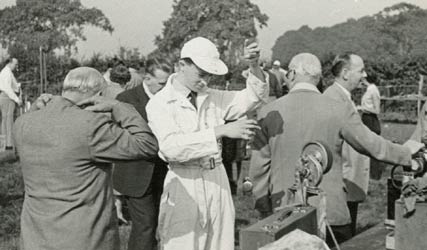 |
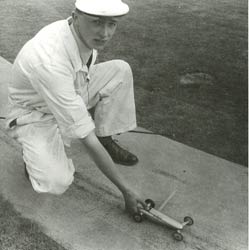 |
| Ron creating his fuel brew at Woodside | Ready to start his 'Bottom's Up' |
Over the next few years, Ron and Jim Dean largely assumed the mantle of 'racing correspondents' in Model Maker with numerous articles on building, and preparation of high speed cars and engines, Jim's largely based on a great deal of experience and success, Ron more on enthusiasm and observation. The tethered car racing scene was changing significantly by the mid 50s, many of the early clubs having folded and pioneer racers retired, as outright speed and racing became the aim. Developments in the smaller classes abounded both at the Edmonton Club and up in Sunderland where the limitations of the Oliver twinshaft were being addressed. Essentially this was because as engines revs increased the tyre sizes had to decrease until ground clearance was almost non existent. Traction and stability with the diminutive Oliver cars also a problem. To overcome this there were all sorts of cleverly engineered solutions with geared drive twinshafts, suspension, twin wheels and more, but a simpler route was to use a standard Oliver aero engine on a spur mount driving through reduction gears.
Although Ron's 1.5cc car held the British record for a while at 74mph and his 2.5cc had registered 85mph he stated that road holding was not the strong point of the Oliver cars and he 'was far from convinced that the move towards geared drive cars would be a winner'. His youthful enthusiasm and criticism of what others were doing probably did not endear him to some fellow competitors who were working on the alternative designs? However, he was of the opinion that there was still mileage in the twinshaft if he could design a car with a longer wheelbase, a far more streamlined shape along with a lower and smaller cross section. A slight flaw in his thinking was that the design would work best on a smooth track with good traction, which he acknowledged did not exist in the UK. Twinshaft and other small cars were a bit lively on British tracks and could often be found with large lumps of lead bolted in to the pans
Rather than produce patterns and have castings made or go to the trouble and expense of beating the pan and body from sheet aluminium, Ron embraced the new technology of composite materials by opting for 'fibreglass'. His design was to be made entirely from GRP, Glass Reinforced Polyester, with an aluminium sheet core for strength and for fixings. By the time Ron had published a long article about the design and building of the car in 1957 it and the Oliver Tiger twinshaft were history as he had abandoned the whole project and also gone the geared route. As far as was known, only Ron's own car was known to exist until 2021 when a second appeared in the USA, believed to have been made by Ron for Bill Bennett of the Maidstone Club. In a strange quirk of fate, this car was sold shortly after and made its way back to the UK.
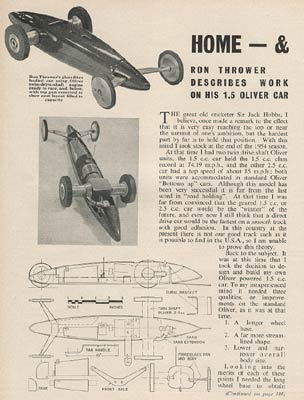 |
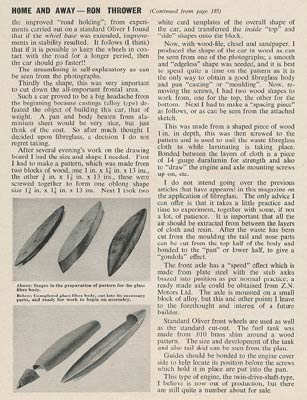 |
| The missing 'Away' in the title refers to Roland Salomon's 'SuperSabre' car | |
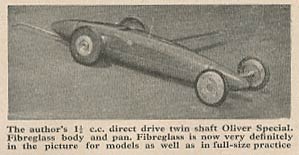 |
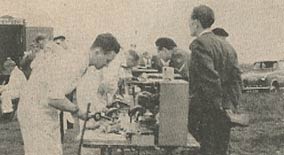 |
| The GRP car in 1956 | Ron at Blackpool Nationals 1956 |
Now that Ron's car had surfaced, it seemed appropriate to give it a run at Buckminster. Unfortunately, the 'Bottom's Up' car could not be run in the state it was found as the MCA had banned cars that exhausted directly on to the track, a rule that is still adhered to in the current Buckminster regulations. The 1.5cc car seemed a realistic proposition, especially as it also has a large lump of lead to keep it under control.
|
Jan Huning was asked if he could lend assistance as he is a whizz with Olivers, but even his ministrations could not produce so much as a 'pop' from the motor, no matter what he did with the compression screw. This required investigation, where a strip down revealed a chamber of horrors. At some point the thread in the head had stripped so a steel insert had be threaded in, which in turn was threaded ¼" x 32tpi. Screwed in to this was a standard glow plug with the core removed and a brass 6BA screw inserted. Unfortunately, this was so short that the contra piston could never be set, so no go. Then a dilemma, entirely rebuild the head or keep the modification and extend the insert to give a decent amount of adjustment or make a new, Oliver style screw? To maintain a degree of fidelity, a longer insert was made, but for the second test session a proper compression screw was fitted. |
|
Whether it would work would have to wait until the next trip to Buckminster in September. The strip down also revealed that one side of the crankshaft was missing a collet so that the wheel was pulling up directly on the bearing. Either it was put together that way as a quick fix in the 60s, or someone has had a fiddle?
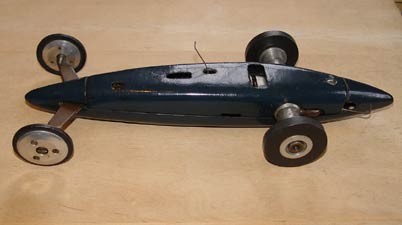 |
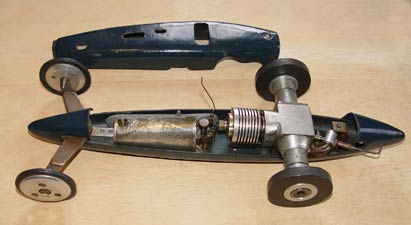 |
| Ron's own 1.5cc car as featured in Model Maker | |
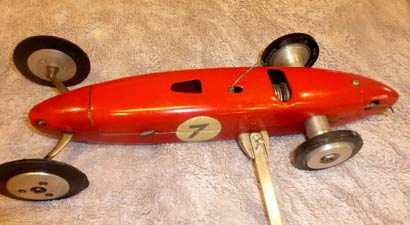 |
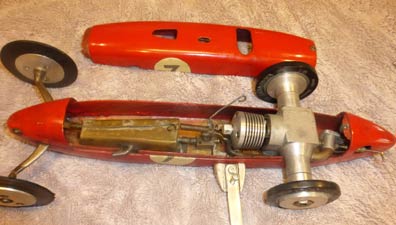 |
| Believed to have been built for Bill Bennett of the Maidstone Club 2.5cc Tiger MkII | |
Ron Thrower Pt II
That was not the end of the 'Thrower story' though as another strange coincidence came to light. Model Maker had published an article in 1956 about a new car being produced as a joint project by Ron and Paul Zere of ZN Motors. The only evidence of this was a single photo taken at Mote Park Maidstone in 1957 that shows Ron with two of these cars. However, in 2023 when the cardboard box of assorted treasures was further investigated, lurking in the bottom were the mortal remains of that long forgotten, commercial, tethered car project that had not been seen previously. This predated the GRP article and Ron's thoughts about twinshafts by some considerable time, so he was obviously pursuing the spur geared car route by the mid 50s at the latest? According to the article, Ron had approached Zere 'some time ago with the hankerings for a really nice 2.5cc car that he would like to own'.
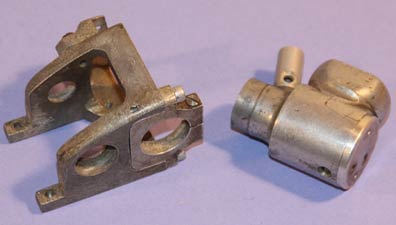 |
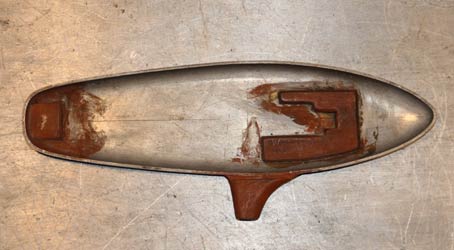 |
| Original ZN spur mount with remains of Oliver | Original pan as a pattern |
|
There were no cars available commercially of this style, which prompted Ron to discuss with Zere the possibility of producing a car along the lines of the very successful ZN 5cc, but for a smaller motor. To reduce production costs, Zere would design the car, produce the pan with spur mount, wheels, tank etc and Ron would build the tops in GRP. The plan was that it would require no machining or engineering at all, just a screwdriver and a couple of spanners. Model Maker published a plan for the car with a price list of the items that ZN provided in the kit and a list of 3rd party parts required, including an Oliver motor (if you could get one that is). The parts for the car were just over £12 and the motor just over £8, so a complete and almost ready to race 2.5cc car for less than £21. |
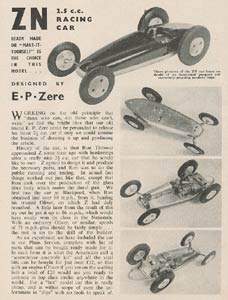 |
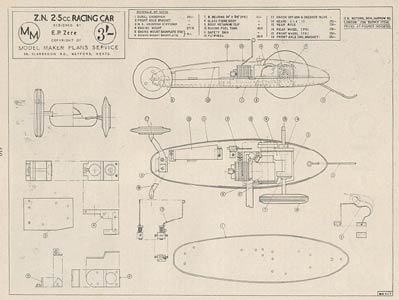 |
|
|
|
The prototype was run at the Blackpool nationals managing just over 80mph, finishing 4th To Stan Drayson, Ken Procter and Alex Snelling. By contrast, Ron's own 1,5cc car finished second, sandwiched between Drayson's two entries. The speed of the ZN car was later increased to 86mph so would have been competitive in the right hands. However, by then most of the top Oliver runners were building their own cars incorporating their own design ideas, so the ZN was not a commercial success. Ron raced a pair of these cars in 1.5cc and 2.5cc classes through to the end of the sport in the UK. To this day though, not a single example had ever come to our notice. |
| Ron at Mote Park in 1957 with ZN based cars | ||
That the box of treasures contained an assortment of cars and parts from both Ron Thrower and ZN, it is a reasonable assumption that the parts discovered were from a pre-production prototype. A margarine tub revealed a ZN spur mount and the tattered remnants of an Oliver MK II that had been modified specifically for that mount. The three piece mount is stamped with the ZN logo on each part and not of a design seen anywhere else. The published plan though shows a mount in the style that Ken Procter developed for his cars. The reason for this became evident when looking at the Oliver motor. Not only did it have to have the lugs removed and have a specially machined backplate, but the actual motor was shortened as well, so a standard motor would not fit, not acceptable for most prospective customers.
|
|
The change in design for the mount was also evident in the pan found in the box. From this it is likely that the pressed pan was due to be replaced with a casting that had a bracket for the tether arm and cast in pads for the 'Procter' engine mount. The last bit of the car to emerge was a GRP top with Ron thrower's logo on it, so I was pretty sure what had been found was the the beginnings of and planned development of the ZN 2.5cc car. With a cast pan the car would be almost identical to Ken's Beretta Rosso described the following year. Was there some tie up between Zere, Thrower and Procter producing a combined design? What was confusing is that the GRP top is similar to the ZN 5cc with the front part of the aluminium pan, but it is too small for a 5cc and the photos of the 2.5 and 1.5 appear to show a full length top? |
As the original spur mount and motor were still together, the immediate plan was to rebuild as it was intended, but a suggestion from John Goodall gave food for thought. As the pattern had been prepared, why not get a casting done so both versions could be completed. Thanks to Andy Soars who was a pattern maker by trade, he tidied up the seventy year old pattern and had some superb castings produced from it. The extra pads and tether bracket were then stripped out so that the pan could then be used as it was originally. This was made significantly easier as the pan already had all the correct holes centre punched as per the plan. The only parts missing to get the car on its wheels were a front and rear axle, so a spring steel front was cut out from a ruler, with a couple of teardrops silver soldered on. The rear was a bit of a head scratcher as ZN wheels used so many different drive fixings, but the wheels in the box were miniature versions of his larger ones using inserted collets.
|
|
The only stumbling block was the somewhat mauled and cannibalised Oliver MKII. Rebuild (if I could get the parts), replace but at what cost now and the tears that would emanate from certain areas as the lugs came off? Well, me being me, it had to be keeping to the original as far as possible and here I am exceedingly grateful to Roger Gedge who provided the internals and Alan Knight who put it all together. A suitably battered set of fins out of Alan's spares box and no outward signs that it was not the original motor. 32 DP gears are still available but even so it was a leap of faith ordering a set as there was no leeway with the mesh. Something of a relief when the gears slipped on to the axle and crankshaft, meshing perfectly. The gears needed thinning a bit, the pinion taper bored for a collet and a flywheel pressed on, so a little bit of engineering required there. |
Then it was down to the tether arm. The original required a sharp, right angle bend where it came out the side of the pan and then a curve to match the bottom of the pan. The new version, a cast in bracket and straight bridle, much safer but not possible unless a bracket was hewn from the solid and bolted on as was so often the case, even on 10cc cars. A bracket just bolted to the aluminium would not be strong enough so a well annealed piece of steel was jig bent to fit, which it did, perfectly, result, and the bolt holes were in exactly the right place as well. A tank was made according to the plan, but with original Oliver 'sneakers' being in short supply, one of Alex's was pressed into service as it exactly matches the Oliver item.
Ron Thrower's GRP top in the box, did not match the pan or the plan, so a case of starting from scratch, oh how I hate making bodies. The continued cold and wet weather precluded any painting or GRP work so the car remains 'topless' at present. Some while ago, and prior to any of the above discoveries, John Goodall had produced a batch of pans and bodies for this car working entirely from the plan in Model Maker. He very kindly offered to make me an aluminium top similar to those he had made and sold, oh the temptation, but GRP it will be, at some stage.
|
So, having completed, more or less, the Zere/Thrower prototype 2.5cc car, that left the small matter of Ron racing both 2.5cc and 1.5cc versions through to the end of his career. What is not known is whether these were built on pressed aluminium pans or castings from the pattern I had acquired? Now, something of a mystery as the cast in feet in the pan were too close together for a 2.5cc Oliver, so was this actually planned as a 1.5cc car? It would have been possible to create a replica of the 1.5cc car using the pan cast from the original pattern, but that would require a Oliver Tiger Cub sans engine mounts, and what would be the chances of finding one of them? |
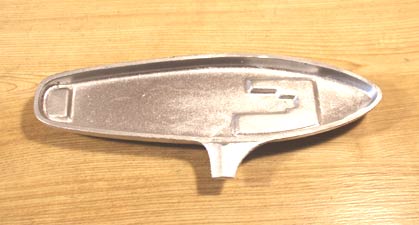 |
Well none, until an email from Alan Knight some months later who had obtained one that had the lugs cut off and wondered what to do with it? What would now be considered butchery was very common in the day. With this news, as Baldrick would say, 'I had a cunning plan'. An Oliver suitably denuded of its lugs is the key to what is otherwise a relatively simple build, just an alternative spur mount to figure out, which does not match the ZN prototype or what is on the plans, so guesswork. Everything else is just a copy of the 2.5car, except it now means two bodies, double the aggravation?
Now for some conjecture. As many of the items in the cardboard box were original ZN, including the spur and bevel drive cars, the assumption is that all of this came from Zere when ZN closed down, but had it all been passed to Ron as his cars were also in the box? What became of Ron Thrower we have no idea, but at least a number of artefacts and articles of his remain to remind us of a short but impressive foray into building and racing tethered cars.
So to Buckminster in September and the GRP car, now with a standard compression screw. Several turns later and at last the engine fired, another couple of flats and it was burbling away happily and sounding good on Nigel's rolling road. Would it perform on the track though? Well, yes, under compressed at first but getting faster each run as a bit more comp was added by Jan. In due deference to the sixty plus year old tyres, we called a halt at that until the next meeting, but it raised another intriguing possibility.
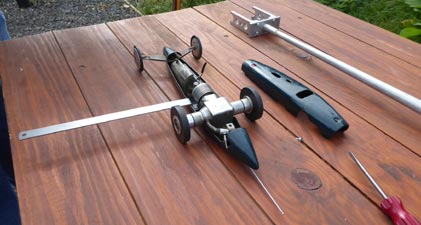 |
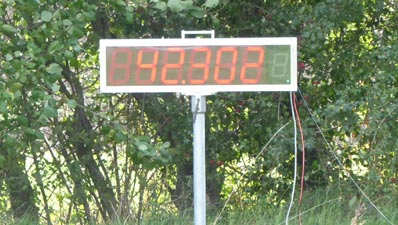 |
| Ready for a first run for 65+years | Plenty fast enough on seventy year old tyres |
|
If the exhaust orifice in the bottom of the 'Bottom's Up' pan could be blocked off without major alteration, might that also be a runner? Not much room to play with, but an aluminium plate was bonded into the pan, held in place by the rear tank screw. Just to add to the aggravation, the original Oliver sneaker valve had been robbed out of the car and the one that John Goodall kindly supplied to replace it was a left handed one for a standard Oliver, which did not match the holes for the one needed on the right of the car, which has a 'curly carb'. Mike Francies came to the rescue with a modified Redfin one that is exactly the right size and had the holes in the right place, phew. New tail skid and ready to run at the SAM Autumn Gala, a more appropriate meeting to air these two venerable and historic cars. |
|
|
|
Thanks again to Jan Huning, the compression screw and needle valve were twiddled appropriately until the Oliver was running sweetly on the rolling road. So, on to the track, a quick push and away it went on its first run since around 1955. Happily, the equally old Raylites lasted the distance (just), but now it will join the GRP car in an honourable retirement. Thanks to the current owner, the meeting provided an ideal opportunity to photograph the two GRP cars together, which illustrated, that although built on a similar principle, they are far from identical, the 2.5cc car believed to have been built for Bill Bennett being much more bulky with a really short bridle. Video action www.youtube.com |
Quite by chance a photo has arrived from Dave Cunliffe who built a replica of the GRP car thirty years ago. Below he describes the building, running and demise of the car. Thanks for this valuable contribution.
|
The Thrower car was a copy I built following the Model Maker description, even using wood for the bucks. I sandwiched an aluminium plate into the pan as described but it ultimately proved too thin for the job. I ran the car several times on a local ex airfield hardstanding using my home made twinshaft (Copeman cylinder/liner) and at a model show in Chippenham using my follow on genuine Oliver TS. The pan cracked at the tether arm bracket and that was that!! The car picture was photographed by Geoff Shepherd. It shows the surface of the Post Office car park well - it was rough but dead flat so the car stayed on the ground and there was a surrounding chain link fence - perfect! |
|
|
|
Some progress on the 1.5cc version of the spur gear car, mostly empirical engineering as it could only be guessed at what was originally intended as no contemporary photos have been found. A bit of reverse engineering from the 2.5cc version had the motor installed then it all came to a shuddering halt through the lack of wheels and tyres of an appropriate size for which the search continues at present. Once wheels and tyres are located then the remainder of the build is little more than a few days, apart from the top, but along with the others, that will have to wait for several months until the 'smelly stuff' can be undertaken outdoors. |
©copyrightOTW2025